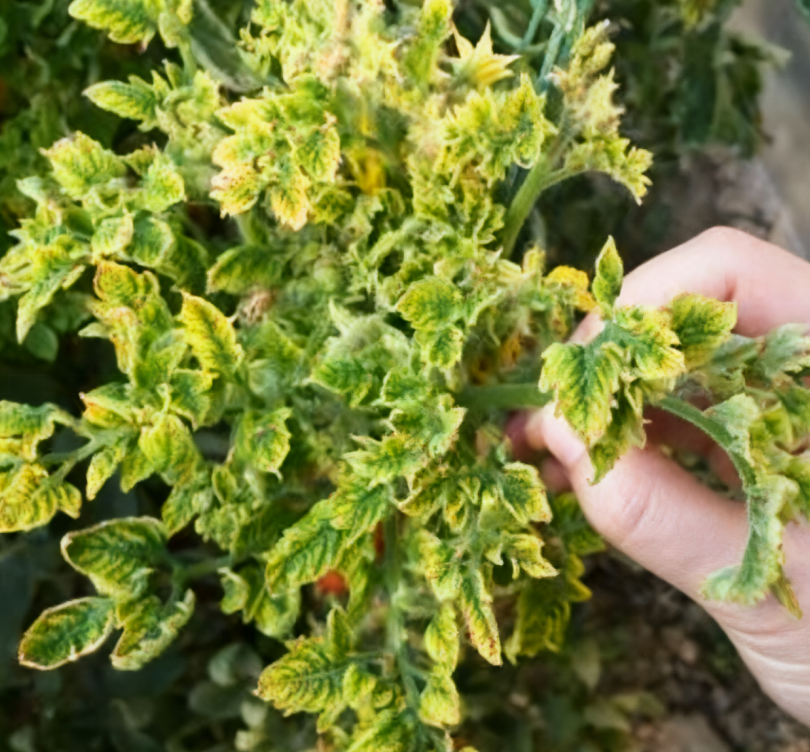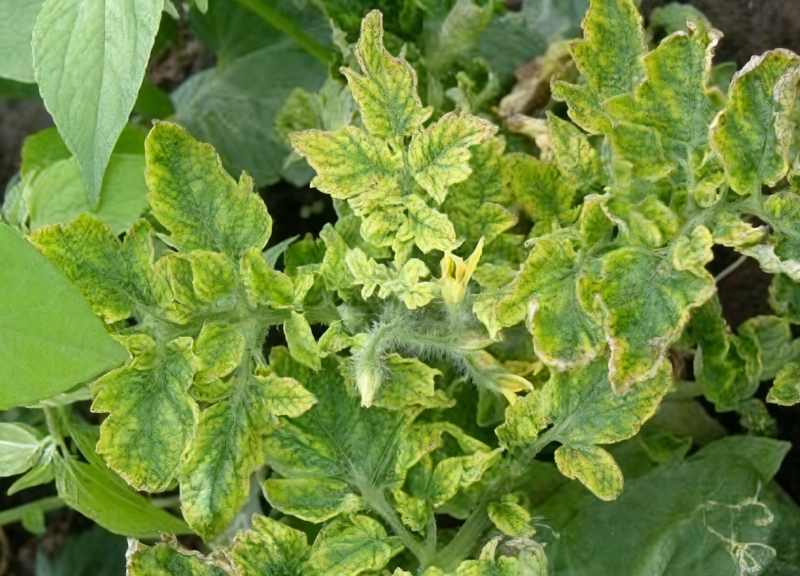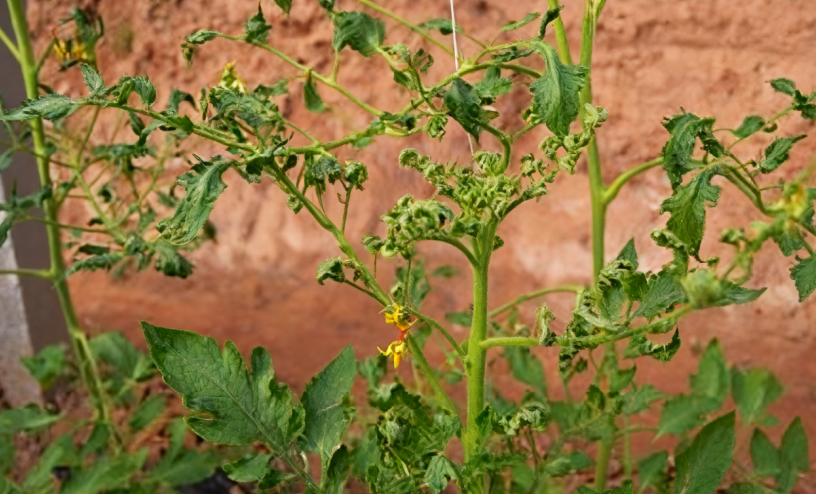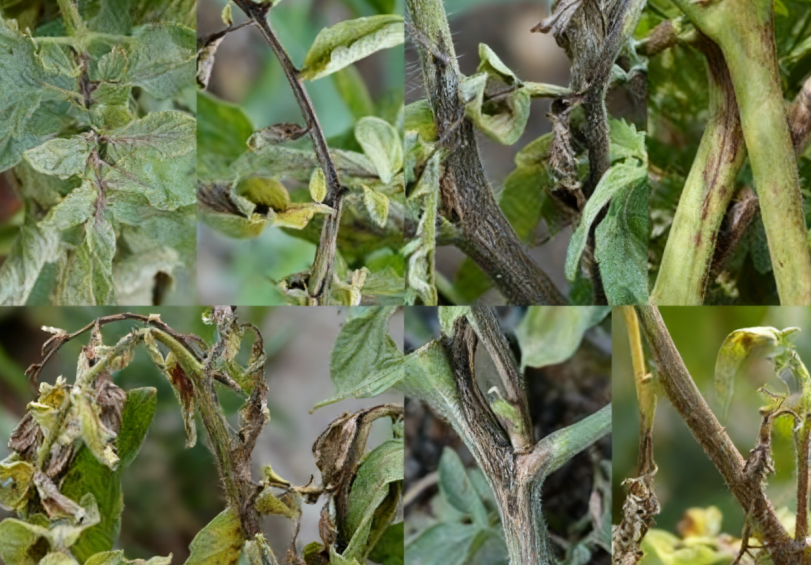Tomato virus disease
1. Introduction
1.1. Tomato virus disease
Is a disease of tomatoes caused by viruses such as Tomato Yellow Leaf Curl Virus and Tomato Spotted Wilt Virus. Different viruses produce different symptoms when they infect tomatoes at different growth stages. When tomatoes are infected with virus diseases, they will have symptoms such as leaf curling, yellowing, brittleness, mosaic leaves, stripes and fern leaves, and dwarfing of plants.

1.2. Causes harm
The quality of tomatoes will decline and the yield may be affected to varying degrees, and in severe cases, there may even be a total loss of the harvest.
1.3. Conditions
It is closely related to environmental conditions and the growth potential of the plants. High temperature and drought are very conducive to the occurrence of viral diseases. Weak plant growth, excessive nitrogen fertilizer application, and soil compaction may all lead to the disease.
1.4. Pathogens
There are many types of viruses that can cause tomato virus diseases, including Tomato Yellow Leaf Curl Virus (TYLCV), Tobacco Mosaic Virus (TMV), Cucumber Mosaic Virus (CMV), Tomato Mosaic Virus (ToMV), Tomato Chlorotic Virus (ToCV), Tomato Spotted Wilt Virus (TSWV) and more than 20 other viruses. Among them, TYLCV and TSWV have a wide range of infection and cause serious tomato yield losses.
1.5. Pathogen growth and reproduction conditions
These viruses prefer high temperature and drought environments. The temperature range suitable for disease occurrence is 15-38℃; the most suitable environment for disease occurrence is 20-35℃ and relative humidity is below 80%; the most suitable growth period for disease occurrence is from the fifth leaf to the middle and late stages of fruit setting. The incubation period for disease occurrence is 10-15 days. Generally, continuous high temperature and drought weather is conducive to the occurrence and spread of diseases.
2. Symptoms of tomato virus disease
2.1. 5 types of performance
(1) Mosaic type: The leaves are mottled with yellow and green or light and dark colors, the veins are transparent, the leaves are thickened, the leaves are slightly wrinkled, and the plants are slightly shorter.

(2)Fern leaf type: The plants are dwarfed, the upper leaves are linear, and the middle and lower leaves are slightly curled.

(3)Stripe type: The plants are dwarfed to varying degrees, starting from the upper leaves, all or part of them become linear, the middle and lower leaves are slightly curled upward, the leaves have brown spots or cloud spots, or brown spots occur on the stems and vines, and the discolored parts are only in the epidermal tissue and do not penetrate deep into the interior; it can occur on leaves, stems, and fruits, with tea-brown spots or cloud patterns on the leaves and dark brown stripe patches on the stems and vines, and the patches do not penetrate deep into the stems and fruits.


(4)Curled leaf type: Yellowing between veins, the edges of the leaves curl upward, the leaflets are twisted and deformed, and the plants are shrunken or clumped.

(5) Necrotic type: The top leaves turn green or yellow, the leaves become smaller, the leaf surface shrinks, the edges curl up, the plant becomes dwarfed, and adventitious branches grow in clusters; some leaves or the entire plant turns yellow, and yellow-brown necrotic spots appear. The spots are irregular in shape, mostly necrotic and drying up from the edges. The fruits of the diseased plants are light gray-green with translucent light white spots showing through.

3. Prevention and treatment methods
3.1. Agricultural prevention and control
3.1.1.Cultivate disease-resistant hybrid varieties
3.1.2.Field management:
(1)For planting, select fields that have not planted tomatoes or have not been infected with tomato virus disease. For fields that have been infected with tomato virus disease, deep plowing must be carried out to promote the rotting of virus-carrying residues. If conditions permit, apply lime to inactivate the virus on the diseased residues in the soil.
(2)Avoid intercropping and continuous cropping to reduce and avoid the transmission of tomato virus disease soil and residues, and reduce the occurrence of virus disease; the nursery and planting sheds should thoroughly remove poisonous weeds to reduce the source of virus disease.
(3)After the tomato seedlings are planted, the shade net should be covered when the temperature in the shed rises to prevent the seedlings from being sunburned and wilting due to lack of water, to ensure that the tomato plants grow healthily and better resist tomato virus disease. Keep the greenhouse ventilated smoothly, control the temperature, and ensure that the tomato is at a suitable growth temperature.
(4)When pruning and cutting branches, remove diseased plants in time, and weeds should also be removed to reduce the host plants of pests such as whiteflies.
(5)Physical control of transmission media: If seedlings need to be raised, cover the seedling shed with 80-100 mesh insect-proof nets, or divide the seedling shed into multiple net rooms of different sizes, and ensure that the entrances and exits are tightly closed. The windproof openings in front of the shed and on the top of the shed should also be equipped with 90-100 mesh insect-proof nets to cut off the entry routes of pests such as whiteflies, so as to effectively control the occurrence of tomato virus diseases. Yellow sticky insect boards can also be hung for trapping and killing.
3.1.3. Chemical control
(1)Seed disinfection: Before sowing, use 100 ml of amino oligosaccharide solution, add 15 kg of water, soak tomato seeds for 15 minutes, then fully dry the seeds to reduce the water content to below 8%, place them in a constant temperature box, and treat them at 72°C for 72 hours to kill the viruses carried by the seeds; you can also use drug disinfection to kill the virus, generally use 10% trisodium phosphate aqueous solution or 0.1% potassium permanganate to soak the seeds for 20-30 minutes, remove them, and rinse them repeatedly until they are clean.
(2)Seedling management: Since March to May in spring and July to September in autumn are the peak breeding periods of pests such as whiteflies, it is necessary to appropriately adjust the sowing time of tomatoes, try to avoid the peak breeding period of pests such as whiteflies, and prevent and control aphids in time. Recommended plan: moroxydine hydrochloride + oligosaccharins + kasugamycin, spray 3 times in a row, spray once a day, and halve the amount used in the seedling stage.
(3)Chemical control of transmission vectors: If whiteflies are present on the plants after planting, chemical control should be adopted to reduce insect transmission vectors. When the tomato has 3-4 leaves and 1 heart, the following solution is recommended: 1500 times dilution of 25% thiamethoxam WP, 2000 times dilution of 10% imidacloprid WP, 2500 times dilution of 25% thiamethoxam WDG, 1500 times dilution of 1.8% abamectin EC for root irrigation.
Other information

